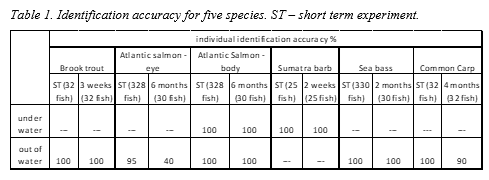FISH INDIVIDUAL IDENTIFICATION – CAN WE SUBSTITUTE INVASIVE TAGGING?
Introduction
The optimization of the fish production in intensive aquaculture can lead to the increase of the production with the respect to the fish welfare. The new technologies enable to develop the Precision Fish Farming (PFF) (Fore et al. 2017) concept whose aim is to apply control-engineering principles to fish production, thereby improving the farmer’s ability to monitor, control and document biological processes in fish farms. Individual fish identification is one of the tasks necessary for precision fish farming.
There are many methods of individual fish identification. The widespread and popular methods of fish identification are tagging and marking (PIT, RFID or VIE tags). Most of the commonly used methods are invasive and can have adverse effects on fishes, increasing the risk of sequelae or mortality, mainly for small and sensitive fish as most of the stream fish species.
Non-invasive fish identification based on the fish appearance is cheap, less stressful for the fish and accurate. Human based identification of individual fish of the same species using the skin pattern was proved by Hirsch (Hirsch 2015). There are several different patterns which can be observed on the fish body (eye pattern, scale pattern, body texture). Even the image of the fish without any obvious pattern can be used for identification. The aim of this paper is to summarize the usability of image-based individual fish identification from the point of view of identification accuracy and pattern stability for long term identification.
Materials and methods
Five image-based individual identification studies were done for five fish species to prove the possibility of automatic computer vision fish identification.
Brook trout - 32 individuals were used for identification. Three data collections of fish out of water using the digital camera were done in 3 weeks. One image of each fish was taken for each session. The fish was automatically detected and the region of interest (ROI), containing unique dot pattern, was determined, Fig.1-A. The texture descriptor histogram of oriented gradients (HOG) was used to create the feature vector for identification. The identification was performed for all combinations of the data collection sessions.
Atlantic salmon – 328 fish individuals were used for identification. Four data collections of the fish out of water and under water were done in 6 months. Eight images per fish were taken for each individual in each session. For the first data collection all 328 individuals were used. Selected 30 fish were tagged and used for next 3 sessions. The HOG descriptor and dots position on the body were used as features for identification, Fig.1-B. The identification was done for all 328 fish for first session and for 30 fish for all sessions. Fish eye pattern was also used for the identification.
Sumatra barb – 25 fish individuals were used for identification. Two data collections were done in 2 weeks. Ten images of the fish under water were collected in each session. The fish was automatically detected in the image and the middle part of the body with two stripes was used as ROI, Fig.1-C. The identification was tested between data collections and within data collections.
Sea bass - 300 fish individuals were used for identification. Two data collections of the fish out of water were done in 2 months. Ten images per fish were taken for each individual in each session. In the first data collection all 300 individuals were used. Selected 32 fish were tagged and used for second sessions. The HOG descriptor was used to generate the features for identification, Fig.1-D. The identification was done for all 300 fish for first session and 32 fish for both sessions.
Common carp 32 fish individuals were used for identification. Four data collections of the fish out of water were done in 4 months. Ten images per fish were taken for each individual in each session. All 32 fish were tagged and used for identification. The HOG descriptor was used to generate the features for identification, Fig.1-E.
Results
Conclusion
Individual fish identification is one of the keystones of the emerging concept of Precision Fish Farming. The series of five studies demonstrated that the image based (fish appearance) individual identification using computer vision can be used for long-term identification. The identification was tested on three species with obvious patterns and two species with ambiguous patterns. High accuracy of the identification was reached for all species together with the long-term pattern stability. Image-based identification is non-invasive and remote approach which can substitute invasive fish identification methods.
Acknowledgement: European Union’s Horizon 2020 research and innovation program under grant agreement No. 652831” (Aquauexcel2020)
Reference:
Fore, M., Frank K., Norton T., Svendsen E., Alfredsen J. A., Dempster T., Eguiraun H., Watson W., Stahl A., Sunde L.M., Schellewald C., Skøien K. R., Alver M. O., Berckmans D. 2017. Precision fish farming: A new framework to improve production in aquaculture, Biosystems Engineering, https://doi.org/10.1016/j.biosystemseng.2017.10.014
Bekkozhayeva, D., Saberioon, M. & Cisar, P. Automatic individual non-invasive photo-identification of fish (Sumatra barb Puntigrus tetrazona) using visible patterns on a body. Aquacult Int (2021).
Schraml, Rudolf & Hofbauer, Heinz & Jalilian, Ehsaneddin & Bekkozhayeva, Dinara & Saberioon, Mehdi & Cisar, Petr & Uhl, Andreas. (2020). Towards fish individuality-based aquaculture. IEEE Transactions on Industrial Informatics.

